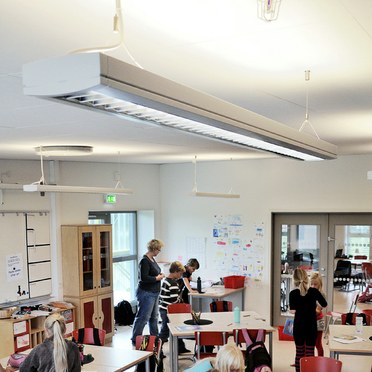Emilia School, Sweden
- Lamp efficacy
Lamp efficacy
Ensuring the lamp efficiently converts electricity into light (lm/W).
- Ballast classification
Ballast classification
Controlling the electricity supply to the lamp (Energy Efficiency Index).
- Luminaire distribution
Luminaire distribution
Controlling light emission using optics which bend and shape the light to the correct location.
- System efficacy
System efficacy
Combining optical and thermal control within the luminaire (luminaire lm/W).
- Presence/absence detection
Presence/absence detection
Providing lighting only when it’s needed.
- Daylight detection
Daylight detection
Reducing waste light during daylight hours.
- Constant illuminance
Constant illuminance
Producing the correct lighting levels for the duration of the maintenance period.
- Task-scene setting
Task-scene setting
Allowing the user to set scenes and adapt the lighting to different tasks.
- Timed off
Timed off
Automatic cut-off to turn all lights off during unoccupied hours.
- Task lighting
Task lighting
Lighting task areas with the correct amount of light.
- Zoning of lighting
Zoning of lighting
Zoning lighting in accordance to occupancy patterns or window location.
- Maintenance schedule
Maintenance schedule
Tailoring maintenance schedules in accordance to product age, performance and environment.
- Waste light
Waste light
Eliminating waste light which does not hit the intended target.
- Reflectance
Reflectance
Taking advantage of light which is reflected from the surface within the space.
- Visible smart metering
Visible smart metering
Enabling results of actions to be quickly seen as increased or decreased energy use to encourage responsible energy consumption.
Passivhaus School uses Thorn luminaires
As part of its commitment to meet the EU's target to increase energy efficiency by 20% by 2020, Landskrona Municipality has opened what it claims is the most energy efficient school in Sweden, Emilia School in Häljarp. Not only is the building constructed by a cost-effective, sustainable design solution, but the lighting is equally sustainable.
Emilia School is one of the first educational facilities built using the passive house technique. A passive house is a mechanically ventilated building that, with a highly insulated and air tight building envelope, uses minimal energy for heating - thus reducing its ecological footprint.
The term "passive house" (Passivhaus in German) refers to a set of voluntary criteria for an ultra-low energy use building and was developed by Prof Bo Adamson of Lund University, Sweden, and Dr Wolfgang Feist of the Institute for Housing and the Environment, Germany.
Extremely efficient lighting must be used in order to meet the primary/source energy targets (the total site energy target is <42 kWh/m2/yr), hence Thorn has delivered a total classroom solution, including the use of lighting controls. Among the many luminaires are Optus IV fluorescents, incorporating 35W T16 lamps and whiteboard options.
An outstanding feature of the lighting is the integration of lighting and heating controls. Bo Hall, Thorn sales representative, said: "Normally it is possible to control the intensity, the daylight and the presence in the rooms, but here the lighting also contributes to the heating of the building."
Emilia School principal Lena Johnsson says that everyone appreciates the good lighting and feels comfortable in the environment. She said: "The lighting solution has not yet been used to help heat up the building, but it is just a matter of time. Soon there will be cold nights again."

